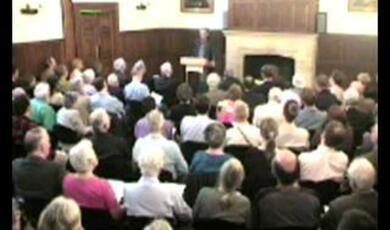Deliberately blinding opponents has always been part of warfare.
Sophisticated protective armour has ancient origins. With the incrementally rising incidence of eye injuries with each successive modern war, eye protection had to be re-invented with often bizarre results.
As the face and eye became a major site of injury; modern plastic surgery was created from the carnage of the trenches in WWI. Further advances occurred with the treatment of burned pilots in the Second World War. The co-operation of artists, sculptors and surgeons led to rehabilitation of many of these people and to a change in public perception of patients with such injuries.
An extraordinary story of extraordinary people reveals how the dedication and humanity of these surgeons led to much that we take for granted in our modern world.
30 October 2013
The Eye at War:
Preventing and treating combat injuries - a 2000 year journey
Professor William Ayliffe
The vulnerability of the head and neck to injury particularly in war has been an issue of concern to humans from ancient times to the present.
Surprisingly the incidence of injuries to the eyes is increasing, reaching record levels in the recent conflicts in the Gulf and Afghanistan.
Working out the best body armour for the eyes, an ancient problem, remains a pressing problem for the military and for civilian eye care providers, long after wars have ceased.
From Bronze Age Greece we have the Corinthian Helmet, a beautifully designed but impractical head protection that was later superseded by the Attic helmet.
These helmets provided protection to the head and neck, but severely impaired hearing and field of vision.
Lighter versions of these nasal helmets were to remain in use until the middle ages when new cavalry tactics and the advent of more sophisticated artillery, in particular the English Longbow, demanded better facial and eye protection.
The most celebrated victim of eye injury in this period was King Harold of England, and although scholarly debate regularly questions the identity of the man depicted under the word hAROLD, the image on the Bayeux tapestry clearly identifies a soldier with an arrow in his eye.
Furthermore, he is not alone and in the last surviving fragment of the tapestry several fleeing soldiers are depicted with ocular injury.
This is an important point about eye injuries. With an injury to a limb, the soldier to a certain degree is able to fend for himself, and perhaps even continue fighting. At the most he may require limited attention to evacuate the field. However, an eye injury is not only devastating to the recipient, but also takes up resources of his fellows to look after him, effectively removing them from the fighting force. The effect on morale of these horrific injuries must also not be underestimated.
In an earlier scene we can see Duke William taking a major risk. An additional problem with nasal helmets was that they obscured the identity of the wearer. When the rumour spread that William had been killed he was forced to lift his helmet to reveal his face to his troops and his identity is proclaimed by Eustace.
Lifting your helmet or your visor was common in warfare, not just to be identified before the days of heraldry but also to allow one to survey the field of battle. With sophisticated accurate archery this was dangerous.
In 1403 at the battle of Shrewsbury, the rebel Henry “Hotspur” Percy was instantly killed by an arrow in the eye when he lifted his visor. His adversary Prince Henry, later King Henry V, was similarly injured. Henry survived due the expertise of a London Barber Surgeon, John Bradmore, who later included a detailed account of the injury and his treatment in his treatise Philomena.
This was the first major battle in which elite English bowmen had faced each other as adversaries and the slaughter and mayhem was appalling, even inciting comment form battle hardened contemporaries.
Many other examples of death by arrows to the face and eye exist. This danger stimulated developments in visor technology.
Apart from artillery, the face and eyes were at risk from splinters of spears and especially lances.
In ritualized warfare such as jousts, the head was a target that scored high points if struck. This put the face in danger and heavily protected helmets were designed specifically to reduce this danger.
Despite wearing these sophisticated helmets, high profile cases of death from shards of lances penetrating the eye through the closed visor are well documented. The celebrated Pass of Honour of Suero de Quiñones in 1434, at Órbigo bridge, caused so many injuries to his loyal companions, including deaths from eye trauma, that the mission had to be abandoned. Nevertheless Suero achieved immortality, being satirized in Don Quixote.
More importantly, these eye injuries could change the course of history. In 1599 during a tournament to celebrate the Peace of Cateau-Cambresis, King Henry II of France was killed by a sliver of a lance that pierced his eye.
Even to this day eye injuries occur in Jousting tournaments, and on occasion deaths ensue.
The advent of gunpowder and highly penetrating bullets, made visors obsolete. In fact, eye protection for infantry was not going to be taken seriously again until modern times, when trench warfare, high explosives and gas were to make the eye a vulnerable target once more.
The First World War changed how the military dealt with eye injury.
Improved protection with gas masks and bizarre eye armour for the tank corps were developed.
One of the most memorable and moving images from that war is John Singer Sargent’s Gassed. This painting reveals not only the horror of mass blinding, but also the military disaster, requiring resources diverted from the front line to look after these casualties.
A system of chain of evacuation was designed to improve the outcomes of battle injuries. After local dressing stations the patient was returned to England where changes in the treatment of facial injuries were being developed.
Although unable to restore sight, pioneer surgeons developed the basic techniques that were to be the invention of modern plastic surgery.
The efforts of the heroic New Zealander, Sir Harold Ellis were documented by several war artists, most famously Henry Tonks.
From these images we are able to see how revolutionary Ellis’ methods were.
Other artists, including Captain Scott’s widow, were to be involved in the rehabilitation of these men suffering from horrible disfigurement and the science of facial prosthetics was born.
In the second World war, Ellis and his even more famous nephew, Sir Archibald Machindoe made astonishing strides in the treatment of facial burns.
The fragments of the canopies of spitfires in the eyes of injured pilots lead to the realization that Perspex was a biocompatible material. From this observation Sir Harold was able to invent the intraocular lens.
This serendipedous discovery has benefited more people in the world than any other surgical operation.
Unfortunately wars still occur. Modern asymmetrical war, with snipers and roadside improvised explosive devices leave the eye as exposed as ever. In fact eye injuries increased so much that major reorganization of their management became a priority in the Afghan War.
So what have we learned over 2,000 years?
Wars are horrible and the eyes are a major target for injury. Preventing these injuries is a priority and managing them quickly to preserve as much sight as possible is essential.
Recent experiments have identified how ballistic shock waves lead to damage of the tissues of the eye and help us understand how to protect the eye and may lead to improvements in surgery.
Rehabilitation of the injured and recognition of their disfigurement by society remains work in progress.
© Professor William Ayliffe 2013


 Login
Login







